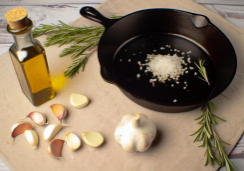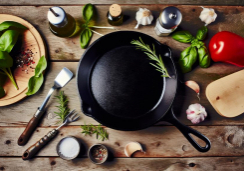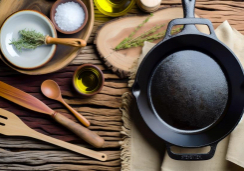4 Secret Techniques for Perfect Gluten-Free Baked Goods
Did you know that nearly one in a hundred people worldwide are affected by celiac disease, with countless others adhering to a gluten-free diet for various health reasons?
You're likely aware that removing gluten from baked goods can lead to disappointing results—think crumbly textures and flavors that fall flat.
However, with the right techniques, you can master the art of gluten-free baking. In this discussion, you'll uncover four secret techniques that will transform your gluten-free baking from mediocre to magnificent.
You'll learn how to finesse gluten-free flours, balance moisture content, and employ alternative binders to achieve the perfect rise and texture.
The best part? These techniques aren't just for professional bakers; they're tailored for your home kitchen.
So, let's begin this journey towards baking excellence and explore the keys to unlocking the full potential of gluten-free treats that will leave your taste buds in awe.
Mastering Gluten-Free Flours
Choosing the right gluten-free flour is crucial for achieving the perfect balance of taste and texture in your baked creations. Unlike traditional wheat flours, gluten-free flours often have unique properties that can significantly affect the outcome of your dishes. To ensure successful gluten-free baking, you'll need to understand these nuances and make precise adjustments.
For instance, gluten-free flours can absorb more liquid than their wheat counterparts, so you might have to tweak the liquid content in your recipes to avoid dry, crumbly results. It's not just about substituting one flour for another; it's about reimagining the recipe to work without gluten.
Moreover, a single gluten-free flour rarely does the trick. You'll likely need a blend. Gluten-free flour blends are specifically designed to mimic the properties of gluten, providing structure and elasticity to your baked goods. Don't forget to incorporate a binder, like xanthan gum or guar gum, to give your gluten-free dough that much-needed cohesiveness.
When you're ready to convert your favorite recipes, start with a trusted gluten-free baking mix or a well-reviewed gluten-free flour blend. Gluten-free baking requires patience and experimentation, but with the right approach, you'll master the art of the gluten-free baking mix and enjoy delicious, texture-perfect treats in no time.
Hydration and Moisture Balance
To achieve the tender crumb and moist texture that's often elusive in gluten-free baked goods, it's essential to carefully manage the hydration and moisture balance within your recipes. Gluten-free flours absorb moisture and fat differently than wheat flour, often requiring adjustments to traditional methods. Your goal is to add moisture without making the batter too wet.
Incorporating pureed fruit, sour cream, or yogurt into your gluten-free recipes can significantly enhance the moisture content. These ingredients offer not only hydration but also a richer flavor. Another trick is to swap white sugar for brown sugar, honey, or agave, which are natural humectants and help retain moisture. However, when you use these liquid sweeteners, remember to reduce other liquids in your recipe to maintain the balance.
An extra egg or a bit of coconut oil can also introduce more moisture. But exercise restraint; too much liquid can lead to a dense or gummy texture. Xanthan or guar gum can help with this by improving the structure, but use them sparingly. Since gluten-free flours are often finer than wheat flour, they can become oversaturated quickly.
Experiment with these adjustments to find the perfect hydration and moisture balance for your delectable gluten-free baked goods.
Structuring With Binders
While managing hydration ensures your gluten-free baked goods stay moist, incorporating the right binders gives them the necessary structure to hold together and maintain a pleasing texture. Without gluten, the protein found in wheat that helps dough rise and stay cohesive, you'll need to use gluten-free alternatives like xanthan gum or guar gum. These binders mimic the elasticity and structure that gluten provides.
When you use gluten-free flour blends, such as those combining rice flour and almond flour, adding xanthan gum or guar gum is essential. An all-purpose gluten-free flour mix that already includes these binders can simplify your baking process. These mixes often contain the right ratio of flour to gum, ensuring your baked goods don't crumble apart.
Remember, the amount of gum needed can vary. Too much and your cake might become gummy; too little, and it could fall apart. Adjusting the level of binders based on your specific recipe and the texture you're aiming for is key. Don't hesitate to experiment with different binding agents and ratios to discover the best outcome for your gluten-free treats.
Lastly, consider starting with pre-made gluten-free baking mixes. They're a great way to get consistent results while you're still learning the ropes of gluten-free baking tips.
Advanced Leavening Strategies
Mastering the art of leavening is crucial in achieving the perfect rise in your gluten-free baked goods, as it compensates for the lack of gluten's natural leavening properties. You'll want to experiment with various leavening agents, like baking powder, baking soda, and cream of tartar, to find the optimal combination that gives you the best texture and structure.
For more even distribution and better results, dissolve your leaveners in liquid before adding them to your dough. This ensures that each bite of your baked good has the same airy quality. Moreover, you might need to adjust the amount of leavening agents when you switch between different gluten-free grains and starches, as they can behave quite differently from one another.
When mixing, techniques such as folding or gently stirring the batter can help retain air and consequently aid in leavening. This approach preserves the air bubbles that contribute to the desired rise.
Also, consider the potential of yeast-based leavening for more complex and flavorful creations. It's a game-changer for breads and other intricate gluten-free goods.
Conclusion
Now you've got the secrets in your apron pocket! Bake with confidence, adjusting those temps and times to nail the perfect bake.
Don't skimp on moisture—your gluten-free treats crave it. Embrace binders like your culinary lifeline, and remember, patience pays off. Let that batter rest.
With these techniques, you'll whip up gluten-free wonders that'll make even wheat lovers swoon. Happy baking, chef—your gluten-free mastery is just a preheated oven away!










